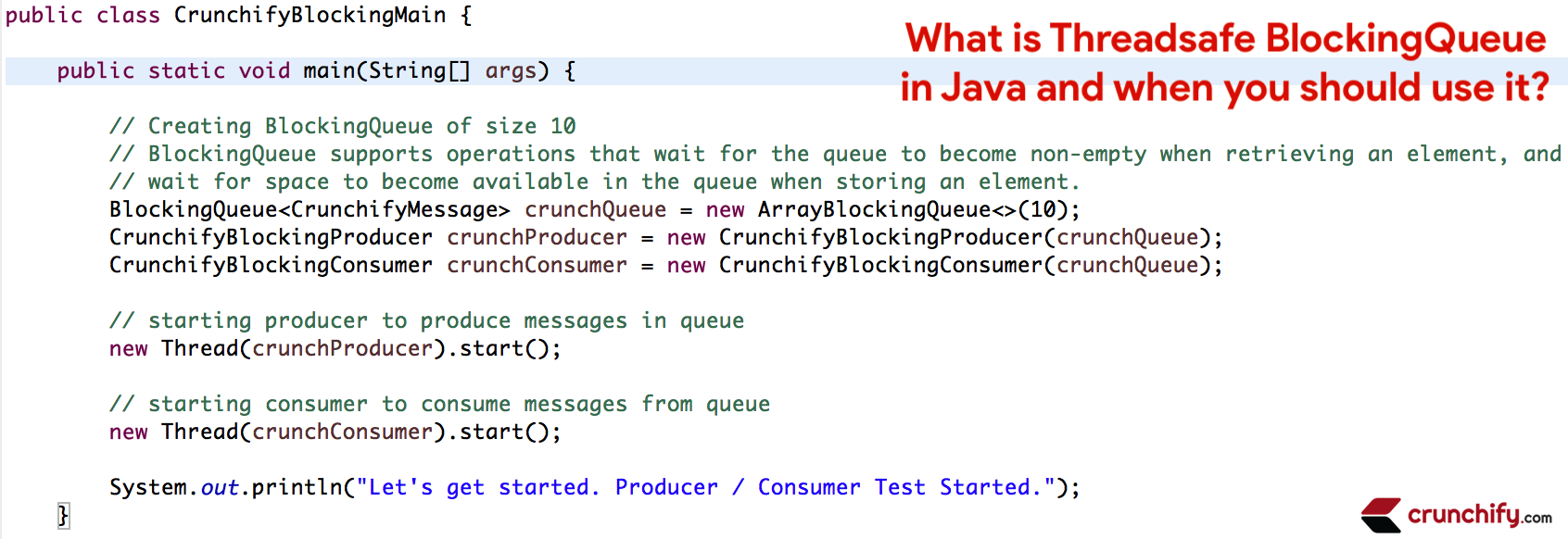什么是 Java 中的线程安全阻塞队列? 你应该什么时候使用它? 附执行
已发表: 2021-04-30
到目前为止,我已经在 Crunchify 上写了两篇关于生产者消费者概念的文章。 第一个解释 Java Semaphore 和 Mutex,第二个解释并发读/写。
在本 Java 教程中,我们将通过相同的生产者/消费者概念来解释BlockingQueue in Java 。
Java中阻塞队列的优点是什么?
java.util.Queue支持在检索元素时等待队列变为非空,并在存储元素时等待队列中的空间可用的操作。

我们需要创建四个 Java 类:
- CrunchifyMessage.java 放置和获取消息
- CrunchifyBlockingProducer.java 将消息放入队列
- CrunchifyBlockingConsumer.java 从队列中获取消息
- CrunchifyBlockingMain.java 开始测试
BlockingQueue 实现是thread-safe 。 所有排队方法本质上都是原子的并且使用内部锁。
让我们开始在 Java 中实现线程安全的 BlockingQueue
第1步
创建类CrunchifyMessage.java 。 这是一个简单的 Java 对象。
|
1 2 3 4 5 6 7 8 9 10 11 12 13 14 15 16 17 18 |
package com . crunchify . example ; /** * @author Crunchify.com * simple Message class to put and get message into queue */ public class CrunchifyMessage { private String crunchifyMsg ; public CrunchifyMessage ( String string ) { this . crunchifyMsg = string ; } public String getMsg ( ) { return crunchifyMsg ; } } |
第2步
创建生产者CrunchifyBlockingProducer.java ,它创建了简单的 msg 并将其放入队列。
|
1 2 3 4 5 6 7 8 9 10 11 12 13 14 15 16 17 18 19 20 21 22 23 24 25 26 27 28 29 30 31 32 33 34 35 36 37 38 39 40 41 |
package com . crunchify . example ; import java . util . concurrent . BlockingQueue ; /** * @author Crunchify.com * */ public class CrunchifyBlockingProducer implements Runnable { private BlockingQueue <CrunchifyMessage> crunchQueue ; public CrunchifyBlockingProducer ( BlockingQueue <CrunchifyMessage> queue ) { this . crunchQueue = queue ; } @Override public void run ( ) { // producing CrunchifyMessage messages for ( int i = 1 ; i < = 5 ; i ++ ) { CrunchifyMessage msg = new CrunchifyMessage ( "i'm msg " + i ) ; try { Thread . sleep ( 10 ) ; crunchQueue . put ( msg ) ; System . out . println ( "CrunchifyBlockingProducer: Message - " + msg . getMsg ( ) + " produced." ) ; } catch ( Exception e ) { System . out . println ( "Exception:" + e ) ; } } // adding exit message CrunchifyMessage msg = new CrunchifyMessage ( "All done from Producer side. Produced 50 CrunchifyMessages" ) ; try { crunchQueue . put ( msg ) ; System . out . println ( "CrunchifyBlockingProducer: Exit Message - " + msg . getMsg ( ) ) ; } catch ( Exception e ) { System . out . println ( "Exception:" + e ) ; } } } |
第三步
创建从队列中消费消息的类CrunchifyBlockingConsumer.java 。
|
1 2 3 4 5 6 7 8 9 10 11 12 13 14 15 16 17 18 19 20 21 22 23 24 25 26 27 28 29 30 31 32 |
package com . crunchify . example ; import java . util . concurrent . BlockingQueue ; /** * @author Crunchify.com * */ public class CrunchifyBlockingConsumer implements Runnable { private BlockingQueue <CrunchifyMessage> queue ; public CrunchifyBlockingConsumer ( BlockingQueue <CrunchifyMessage> queue ) { this . queue = queue ; } @Override public void run ( ) { try { CrunchifyMessage msg ; // consuming messages until exit message is received while ( ( msg = queue . take ( ) ) . getMsg ( ) ! = "exit" ) { Thread . sleep ( 10 ) ; System . out . println ( "CrunchifyBlockingConsumer: Message - " + msg . getMsg ( ) + " consumed." ) ; } } catch ( InterruptedException e ) { e . printStackTrace ( ) ; } } } |
第四步
创建运行 BlockingQueue 测试的简单CrunchifyBlockingMain.java方法。 运行这个程序来检查 BlockingQueue 的行为。

|
1 2 3 4 5 6 7 8 9 10 11 12 13 14 15 16 17 18 19 20 21 22 23 24 25 26 27 28 29 30 |
package com . crunchify . example ; import java . util . concurrent . ArrayBlockingQueue ; import java . util . concurrent . BlockingQueue ; /** * @author Crunchify.com * */ public class CrunchifyBlockingMain { public static void main ( String [ ] args ) { // Creating BlockingQueue of size 10 // BlockingQueue supports operations that wait for the queue to become non-empty when retrieving an element, and // wait for space to become available in the queue when storing an element. BlockingQueue <CrunchifyMessage> crunchQueue = new ArrayBlockingQueue < > ( 10 ) ; CrunchifyBlockingProducer crunchProducer = new CrunchifyBlockingProducer ( crunchQueue ) ; CrunchifyBlockingConsumer crunchConsumer = new CrunchifyBlockingConsumer ( crunchQueue ) ; // starting producer to produce messages in queue new Thread ( crunchProducer ) . start ( ) ; // starting consumer to consume messages from queue new Thread ( crunchConsumer ) . start ( ) ; System . out . println ( "Let's get started. Producer / Consumer Test Started.\n" ) ; } } |
BlockingQueue不接受空元素。 在尝试添加、放置或提供null时,实现会抛出NullPointerException 。
null用作标记值以指示轮询操作失败。
结果:
|
1 2 3 4 5 6 7 8 9 10 11 12 13 14 |
Let 's get started. Producer / Consumer Test Started. CrunchifyBlockingProducer: Message - i' m msg 1 produced . CrunchifyBlockingProducer : Message - i 'm msg 2 produced. CrunchifyBlockingConsumer: Message - i' m msg 1 consumed . CrunchifyBlockingConsumer : Message - i 'm msg 2 consumed. CrunchifyBlockingProducer: Message - i' m msg 3 produced . CrunchifyBlockingConsumer : Message - i 'm msg 3 consumed. CrunchifyBlockingProducer: Message - i' m msg 4 produced . CrunchifyBlockingConsumer : Message - i 'm msg 4 consumed. CrunchifyBlockingProducer: Message - i' m msg 5 produced . CrunchifyBlockingProducer : Exit Message - All done from Producer side . Produced 50 CrunchifyMessages CrunchifyBlockingConsumer : Message - i ' m msg 5 consumed . CrunchifyBlockingConsumer : Message - All done from Producer side . Produced 50 CrunchifyMessages consumed . |
什么时候应该使用 java.util.concurrent.BlockingQueue?
- 当您想限制某种传入请求时,您应该使用相同的
- 生产者可以通过无限队列远远领先于消费者。 如果消费者没有赶上生产者,那么它可能会导致
OutOfMemoryError。 在这种情况下,最好向潜在的生产者发出队列已满的信号,并在失败时迅速放弃。- 换句话说:生产者自然受到限制。
- 阻塞队列通常用于并发应用程序
- 它提供了正确的、线程安全的实现
- 内存消耗也应该受到限制
